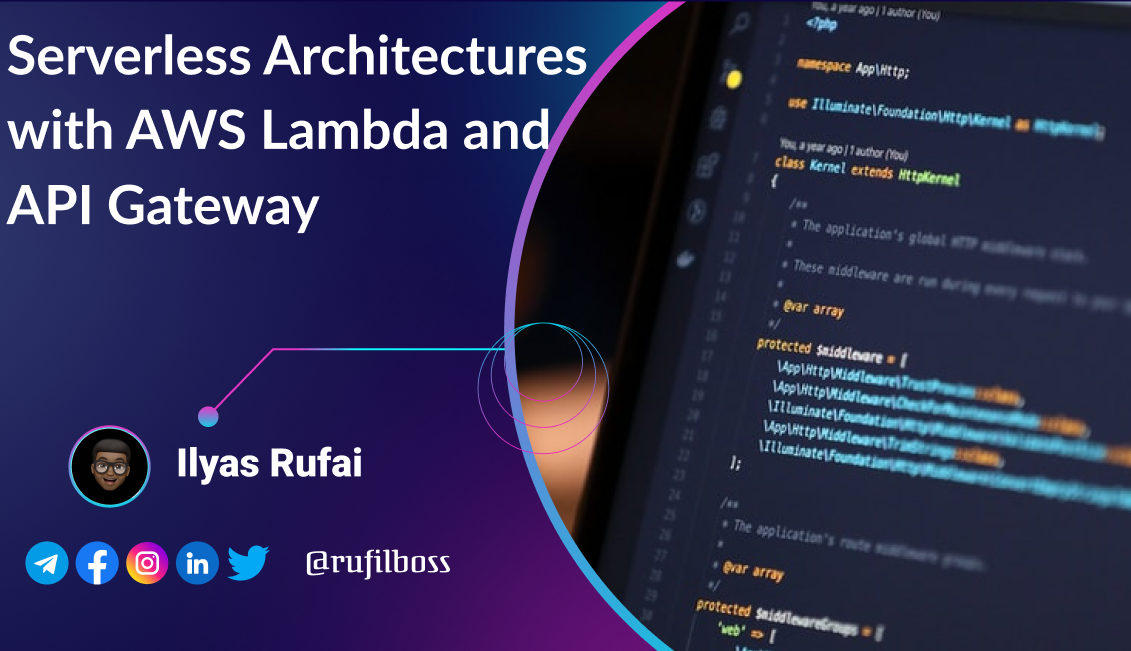Serverless Architectures with AWS Lambda and API Gateway
 ILYAS RUFAI
ILYAS RUFAI
Introduction
Serverless architecture is a paradigm where you build and run applications without having to manage the underlying infrastructure. AWS Lambda and API Gateway are core services in Amazon Web Services (AWS) that enable you to create serverless applications. This article will explain how to build, deploy, and manage serverless applications using these services, and provide real-world use cases, best practices, and potential pitfalls.
What is AWS Lambda?
AWS Lambda is a computing service that lets you run code without provisioning or managing servers. You pay only for the compute time you consume. With Lambda, you can run code for virtually any application or backend service with zero administration. Upload your code, and Lambda takes care of everything required to run and scale your code with high availability.
What is Amazon API Gateway?
Amazon API Gateway is a fully managed service that makes it easy for developers to create, publish, maintain, monitor, and secure APIs at any scale. API Gateway acts as a "front door" for applications to access data, business logic, or functionality from your backend services, such as workloads running on AWS Lambda, EC2, or any web application.
Building Serverless Applications with AWS Lambda and API Gateway
Step 1: Creating a Lambda Function
Log in to the AWS Management Console and navigate to the Lambda service.
Create a new function by selecting "Create function."
Choose the function blueprint or start from scratch.
Configure the function, including:
Function name: Give your function a descriptive name.
Runtime: Choose the runtime for your function (e.g., Python, Node.js, Java).
Role: Define the role and permissions for your Lambda function.
Write your code in the inline editor or upload a .zip file containing your code and dependencies.
Configure the function's trigger. This can be an API Gateway, S3 bucket, DynamoDB table, etc.
Save and deploy the function.
Example Lambda Function
Here's a simple example of a Python Lambda function that returns a greeting message:
def lambda_handler(event, context):
name = event.get('name', 'World')
return {
'statusCode': 200,
'body': f'Hello, {name}!'
}
Step 2: Setting Up API Gateway
Navigate to the API Gateway service in the AWS Management Console.
Create a new API by selecting "Create API."
Choose the protocol (REST or HTTP API).
Define the API endpoint and resource paths.
Configure the integration with your Lambda function:
Method: Choose the HTTP method (GET, POST, etc.).
Integration type: Select "Lambda Function."
Lambda function: Choose the Lambda function you created earlier.
Deploy the API:
Stages: Create a new stage (e.g., dev, prod).
Invoke URL: Note the URL that will be used to invoke the API.
Example API Gateway Integration
Here's how to configure a GET method to trigger the Lambda function:
Create a resource and select "Create Method."
Select GET as the method type.
Choose "Lambda Function" as the integration type.
Specify the Lambda function you created earlier.
Deploy the API and test the endpoint.
Real-World Use Cases
Web Application Backend: Serves as the backend for web applications, handling tasks like user authentication, data processing, and CRUD operations.
Microservices: Implement individual microservices that are lightweight and scalable, with each Lambda function serving a specific purpose.
Event-Driven Processing: Automatically respond to events such as file uploads to S3, changes in DynamoDB tables, or messages in an SQS queue.
Data Transformation: Process and transform data streams in real-time using services like Kinesis and Lambda.
Best Practices
Keep Functions Small and Focused: Each Lambda function should perform a single task or a small set of related tasks.
Minimize Cold Starts: Optimize function cold start times by using lighter runtimes and keeping dependencies minimal.
Use Environment Variables: Store configuration details such as database connection strings and API keys in environment variables.
Implement Proper Error Handling: Ensure your functions handle errors gracefully and provide meaningful error messages.
Monitor and Log: Use AWS CloudWatch to monitor performance and log function execution details for troubleshooting.
Potential Pitfalls
Cold Starts: Initial invocation of a Lambda function can be slow due to the time it takes to initialize the function. This can be mitigated with provisioned concurrency.
Timeouts: Functions have a maximum execution timeout of 15 minutes, which may not be suitable for long-running tasks.
Cost Management: While serverless can be cost-effective, poorly optimized functions or high-frequency invocations can lead to unexpectedly high costs.
Complexity in Debugging: Debugging distributed serverless applications can be challenging due to the lack of a traditional server environment.
Conclusion
Building serverless applications with AWS Lambda and API Gateway allows developers to focus on writing code without worrying about the underlying infrastructure. By following best practices and being aware of potential pitfalls, you can effectively leverage these services to create scalable, cost-effective, and efficient applications. Whether you are building a simple API or a complex event-driven system, AWS Lambda and API Gateway provide the tools needed to succeed in the serverless world.
Subscribe to my newsletter
Read articles from ILYAS RUFAI directly inside your inbox. Subscribe to the newsletter, and don't miss out.
Written by

ILYAS RUFAI
ILYAS RUFAI
I'm a DevOps engineer | Technical Writer | Open Sourcer Building: https://logiq.netlify.app/